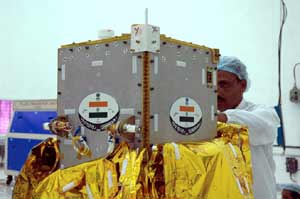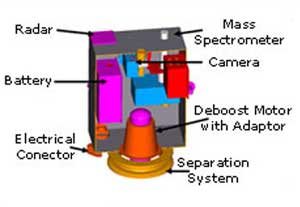Indian flag to be fourth on moon-Mars mission: ISRO chief
21 Oct 2008
New Delhi: When the Chandrayaan-launched moon impact probe (MIP) hurtles down towards the lunar surface, amongst other payloads it will be carrying an item of special significance for ISRO scientists – the Indian flag. A successful conclusion of the MIP sub-mission will see India becoming only the fourth country after the US, Russia and Japan to plant its flag on the lunar surface.
 Given the increasingly envious response that the Indian lunar mission is already evincing in foreign capitals, unused as they are to the thought of Asian nations such as India and China successfully launching increasingly sophisticated space programmes, the launch of the MIP will indeed be a proud moment for ISRO and the nation.
Given the increasingly envious response that the Indian lunar mission is already evincing in foreign capitals, unused as they are to the thought of Asian nations such as India and China successfully launching increasingly sophisticated space programmes, the launch of the MIP will indeed be a proud moment for ISRO and the nation.
According to ISRO chairman, G Madhavan Nair, the presence of the Indian flag on the moon will help establish its presence on the earth's only natural satellite.
Nair said: "Today, as per the international charter, the moon belongs to the global community. Nobody can make special claim on the surface. But in due course, we don't know how things will change. But our presence will be established through this mission."
Nair also reiterated that ISRO would put a man in space by 2015. "If certain finer observation are to be made, online decisions have to be made, the presence of man becomes important," he said.
"The reaction time for any decision will be a fraction of a second, whereas you know it takes almost eight seconds for the data to come from the moon to the earth and then again sent back and so on, and here also somebody has to analyse....so ultimately if you want to do a perfect experiment, a man behind the instrument is a must."
Nair added, "In the Indian context we are committed to taking the space technology for grass root applications. We have done that and we will continue to do so. So nearly 80 per cent of the budget is going to be spent on programmes which are relevant to the common man."
Chandrayaan is set for launch on Wednesday. Amongst other missions, it will also seek the presence of water on the lunar surface. According to Nair, "If you are thinking of establishing a lunar colony, water is an essential element for that and if from it you can generate oxygen, and also if you can decompose and generate it into fuel, which is required for interplanetary travel, so the presence of water is a very-very important element for further exploration."
Nair also confirmed that the mission would look for Helium-3, one of the fuels for nuclear fusion. "Even one tonne of that can sustain the entire country's energy for one year," he pointed out. Reiterating that there was Helium-3 on the moon, he added: "Is it in abundant quantity, whether we can exploit, these are question marks."
The ISRO chief also said that after the moon, the organisation had its sights set on Mars. "The GSLV can take a nearly 500 kg spacecraft to Mars. So if there are good ideas about experimental exploration of that system we can have the Mars mission in about 3-4 years."
"If we want to maintain our leadership naturally we have to have the scientific goals, which is set ahead so that we can be really either at par or ahead of the others in some of the fields. So this is a really challenging task. We believe that India, such a big nation, huge resources, both natural and human resource... we should be in leadership position as far as our space technology is concerned."
 In the course of an interview to a media agency, Nair emphasised that for every rupee spent, ISRO would give back Rs1.50 to Indian society. "That is the first part of it. The second part is the human resource and the technology we create, that is not valued. That is tremendous."
In the course of an interview to a media agency, Nair emphasised that for every rupee spent, ISRO would give back Rs1.50 to Indian society. "That is the first part of it. The second part is the human resource and the technology we create, that is not valued. That is tremendous."
Asked if India have a colony on the moon sometime, Nair said: "We cannot lag behind others in this race. We have to really catch up and we should have our own technology for the manned capsule.
"Of course initial thing would be around earth itself, then from there how to send a man to the moon etc has to be considered. And today with the economic growth what you are seeing in the country this is affordable.
"And a very small fraction of the national budget we spend on space technology. It is really worth it. In fact if you take the entire budget for the space programme it is like 0.2-0.3 (per cent) of the national budget. So it is very small compared to...others are using even up to 2 or 3%."




















